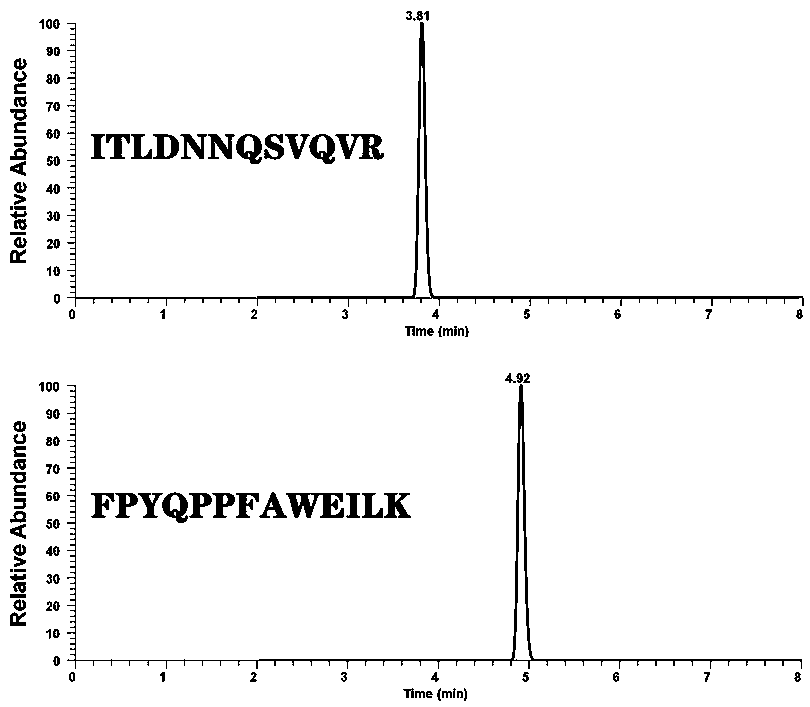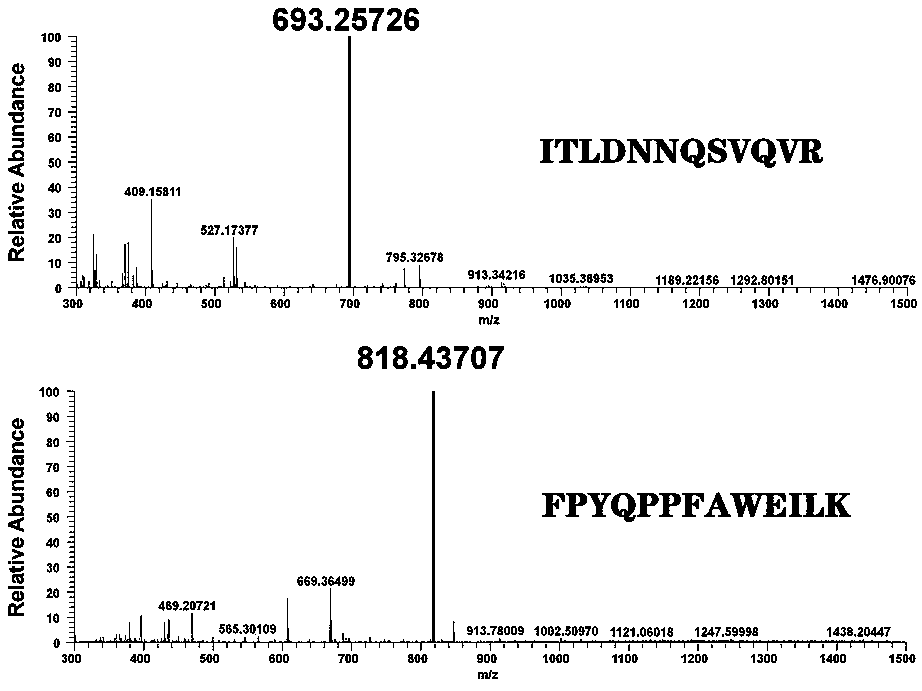Method for detecting apis mellifera and apis cerana glucose dehydrogenase in honey through liquid chromatography-tandem mass spectrometry
A technology of glucose dehydrogenase and tandem mass spectrometry, which is applied in the field of detection of glucose dehydrogenase in honey by liquid chromatography tandem mass spectrometry, achieving the effects of strong specificity, high specificity and sensitivity, and high sensitivity
- Summary
- Abstract
- Description
- Claims
- Application Information
AI Technical Summary
Problems solved by technology
Method used
Image
Examples
Embodiment 1
[0051] 1. Sample source
[0052] Purchase a total of 20 samples of real honey from the market or beekeeper.
[0053] 2. Experimental procedure
[0054] 2.1 Solution preparation
[0055] 5M Urea solution: Weigh 4.5 g of Urea and dilute the volume of ultrapure water to 15 mL;
[0056] 100 mM DTT: Weigh 308.5 mg of DTT, 40 mM NH 4 HCO 3 The volume of the solution is adjusted to 20 mL, each tube is 1 mL aliquoted, and stored in a refrigerator at -20°C until use.
[0057] 40 mM NH 4 HCO 3 Solution: weigh 0.316 g NH 4 HCO 3 , Use ultrapure water to make a constant volume of 100 mL, and store in a refrigerator at 4°C until use.
[0058] 100 mM IAA solution: weigh 0.39 g of IAA and use 40 mM NH 4 HCO 3 The solution is dissolved to 20 mL, and stored in a refrigerator at -20°C until use.
[0059] Activation solution: 500 μL ACN, 3 μL TFA, dilute ultrapure water to 1 mL, and store at 4°C.
[0060] Equilibrium solution: 1 μL TFA, dilute ultrapure water to 1 mL, and store at 4°C.
[0061] Eluent: 800 μL ...
Embodiment 2
[0078] Example 2 Detection of honey adulteration
[0079] 1. Sample source
[0080] Buy real Chinese honey, Italian honey samples and syrup from the market or beekeeper.
[0081] 2. Experimental steps
[0082] (1) Solution preparation
[0083] The same as in Example 1.
[0084] (2) Mixing of honey: Add Italian honey to the middle honey in different proportions.
[0085] The honey is mixed with Italian honey in proportions of 5%, 10%, 20%, and 50%.
[0086] (3) Pretreatment of honey samples
[0087] ①Accurately weigh 10 g of uniform honey to be tested into a 50 mL centrifuge tube, add 10 mL of deionized water, and vortex until the honey is fully dissolved. Centrifuge at 12000 rpm and 4°C for 10 min. Collect the supernatant in a new 2 mL centrifuge tube.
[0088] ②Pipette 200 μL of protein solution and 800 μL of 40 mM NH 4 HCO 3 mixing. Add 100 μL of 30 mM DTT solution to the above mixed solution, react at room temperature for 60 min, and then add 500 μL of 100 mM IAA solution to react in t...
Embodiment 3
[0094] Example 3 Detection of honey in commodities
[0095] 1. Sample source
[0096] 50 bottles of Chinese honey from different manufacturers purchased from the mall.
[0097] 2. Experimental steps
[0098] (1) Solution preparation
[0099] The same as in Example 1.
[0100] (2) Pre-processing of samples to be tested
[0101] ①Accurately weigh 10 g of uniform honey to be tested into a 50 mL centrifuge tube, add 10 mL of deionized water, and vortex until the honey is fully dissolved. Centrifuge at 12000 rpm and 4°C for 10 min. Collect the supernatant in a new centrifuge tube.
[0102] ②Pipette 200 μL of protein solution and 800 μL of 40 mM NH 4 HCO 3 mixing. Add 100 μL of 30 mM DTT solution to the above mixed solution, react at room temperature for 60 min, and then add 500 μL of 100 mM IAA solution to react in the dark at room temperature for 60 min.
[0103] ③Add 30 μL of trypsin solution to each sample and digest at 37°C overnight. When the digestion reaction is complete, add 1 μL of ...
PUM
 Login to View More
Login to View More Abstract
Description
Claims
Application Information
 Login to View More
Login to View More - R&D
- Intellectual Property
- Life Sciences
- Materials
- Tech Scout
- Unparalleled Data Quality
- Higher Quality Content
- 60% Fewer Hallucinations
Browse by: Latest US Patents, China's latest patents, Technical Efficacy Thesaurus, Application Domain, Technology Topic, Popular Technical Reports.
© 2025 PatSnap. All rights reserved.Legal|Privacy policy|Modern Slavery Act Transparency Statement|Sitemap|About US| Contact US: help@patsnap.com



